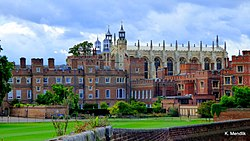
1. The Japanese Landscape
Composed of three garden areas, the Japanese Landscape provides an unique sense of relaxation during your visit to Kew gardens. Reminiscent of a traditional Japanese tea garden, the Garden of Peace, featuring stone lanterns and a dripping water basin.
Raked gravel and large rocks in the sloped garden of Activity represent the movement of the flowing water. The garden of harmony unites thee two. All three gardens combine to form a peaceful, manicured oasis.
At the centre of the Japanese Landscape is the Chokushi-Mon, or Gateway of the Imperial Messenger. It was created for the Japan-British Exhibition of 1910 and is a replica of the Gate of Nishi Hongan-ji (Western Temple of the Original Vow) in Kyoto, Japan. Its finely carved wooden panels feature stylized flowers and animals that depict an ancient legend.
2. The Temperate House
The Temperate House, originally opened in 1863, is the world’s largest Victorian glasshouse. It has been an iconic landmark of Kew for more than 250 years. The Temperate House reopened in 2018 after a five-year renovation project.
Filled with 10,000 individual plants, it is home to 1,500 species from Africa, Australia, New Zealand, the Americas, Asia, and the Pacific Islands, including some of the world’s rarest and most threatened temperate plants. All of the species require conditions above 50 degrees to survive.
3. The Treetop Walkway
You’ll find 14,000 trees in Kew Gardens. The walkway provides an opportunity to get closer to those trees and offers views of the garden and the city beyond.
Made of weathered steel that blends into the natural environment, the walkway stands 59 feet tall. It is 656 feet long and loops through the upper branches of beech, sweet chestnut, horse chestnut, and oak trees.
The walkway offers a unique, ethereal perspective of nature. You’ll love watching bird and insect behaviour at this height and hearing the breeze rustling the branches.
The 188 steps to the walkway are a manageable climb, since the steps are broken up into several flights and there’s a landing at the end of each flight. There is room on each landing to step out of the path of oncoming climbers to rest or simply take a few moments to admire the view. The walkway itself has chest-high railings, and several circular jut-outs along the way provide additional viewpoints. There is an elevator, but it was out of service on the day I visited. If you plan to use the elevator, check the Kew Gardens website for information about the elevator’s status. As I write this, the site says that the elevator is currently out of service.
There is no additional charge to access the Treetop Walkway. It closes an hour before the whole garden closes.
4. The Palm House
The Palm House, which opened in 1848, was the first glasshouse to be built at Kew Gardens. Inside, you’ll find lush vegetation and dense, moist air. Many of the plants in the collection are endangered in the wild, and some are even extinct.
Rainforest plants cover only 2 percent of the world’s surface but make up 50 percent of plant species. Look for the Madagascar periwinkle, now used to treat a number of different types of cancer; the rubber tree; the cocoa tree; and the cycads, or palm-like plants that were widespread more than 250 million years ago.
5. The Princess of Wales Conservatory
This conservatory is the newest glasshouse at Kew Gardens. It opened in 1987, and its 10 computer-controlled climate zones showcase a variety of ecosystems. In the carnivorous plant zone, you’ll find predatory plants such as Venus flytraps and pitcher plants.
There are cacti and succulents in the dry tropical zone, orchids and bromeliads in the steamy zones, and a giant water lily in the wet tropical zone, making this conservatory a diverse one to explore.













